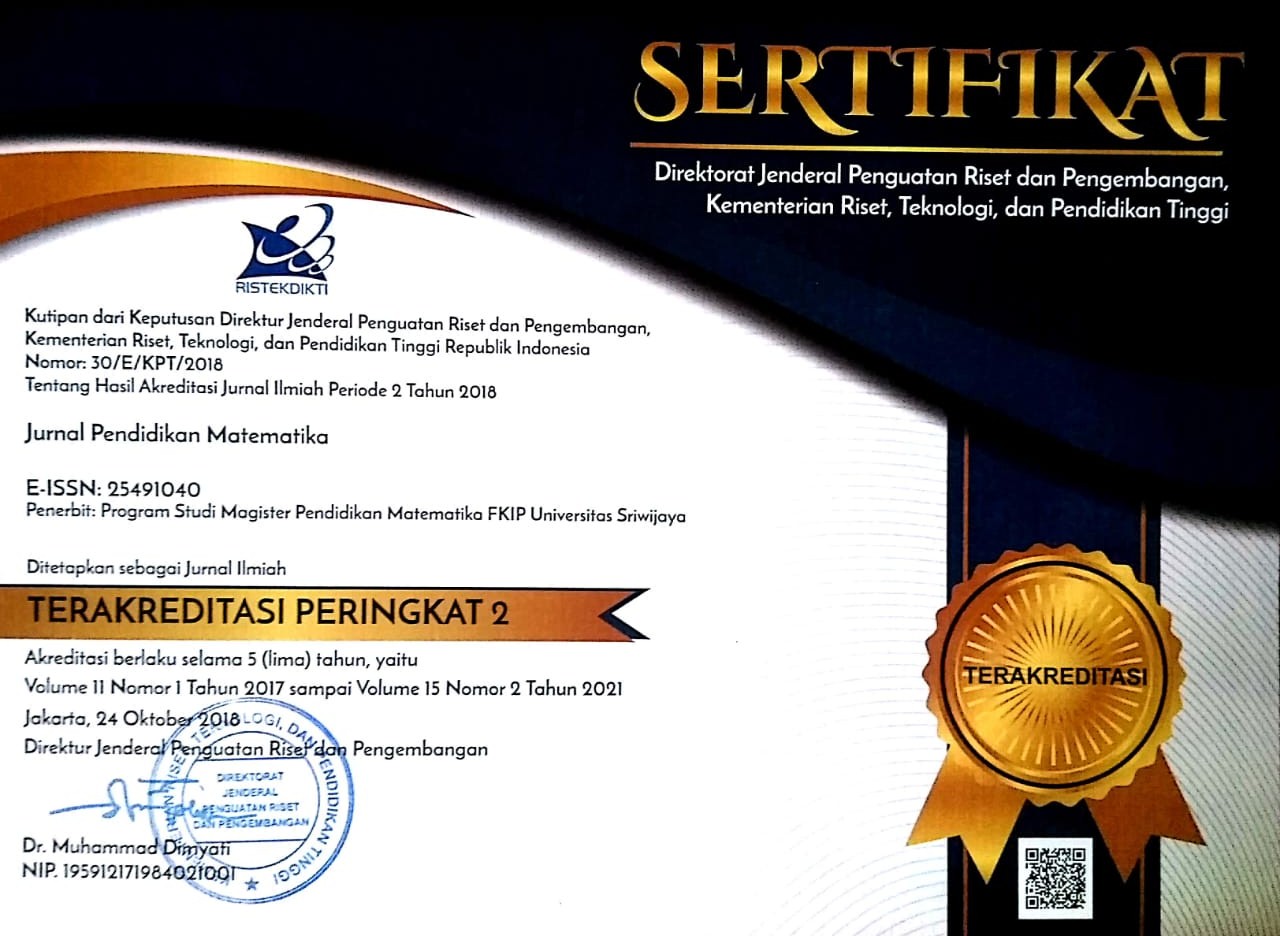The Development of PISA-based Numerical Problem Using the Context of Religious Day during the Pandemic
Abstract
This study aims to produce valid and practical PISA-based numerical problems in the context of the pandemic period and to find out the role of the questions in the form of potential effects on the mathematical literacy skills of secondary school students. This research uses developmental research design, which has 2 stages, namely preliminary and formative evaluation (self evaluation, expert review, one-to-one and small group validation, and field test). The participants in this study were students in Grade 8 who were under the age of 15 and different levels of skills. Data analysis was done descriptively by conducting observations, tests, interviews, and document analysis. The research was conducted face-to-face and via Zoom and WhatsApp Group (WAG) to produce valid and practical PISA-like arithmetic questions. Based on the students' responses, it can be stated that the questions presented are in the practical category because they can be completed quickly by students, they can be understood well by students, and they have the potential effect on students' mathematical literacy skills. In addition, there is a diversity of answers between one students and another according to the level of difficulty that is appropriate for Grade 8 students. This proves that a PISA-like numeration problem in the context of the religious day during a pandemic can help improve students' mathematical literacy.
Keywords
Full Text:
PDFReferences
Ahyan, S., Zulkardi, and Darmawijoyo. (2014). Developing mathematics problems based on PISA level. Journal on Mathematics Education, 5(1), 47-56. https://doi.org/10.22342/jme.5.1.1448.47-56
Azizah, A. L., Zulfiani, B. M., & Muslim, B. (2017). The Influence of Inquiry-Based Learning (IBL) on Students' Science Literacy Ability [in Bahasa]. https://doi.org/10.15408/es.v9i2.5406.
Bakker, A. (2018). Design research in Education: A Practical Guide for Early Career Researchers. London: Routledge.
Bakker, A., & Wagner, D. (2020). Pandemic: lessons for today and tomorrow?. Educational Studies in Mathematics, 104(1), 1-4. https://doi.org/10.1007/s10649-020-09946-3
Bayram, Zeki., Oskay, O.O., Erdem, Emine., Ozgur, S. D., Sen, Senol. (2013). Effect of Inquiry-Based Learning Method on student's motivation. Procedia-Social and Behavioral Science, 106, 988-996. https://doi.org/10.1016/j.sbspro.2013.12.112
Charmila, N., Zulkardi, Z., & Darmawijoyo, D. (2016). Development of PISA model math problems using the Jambi Context [in Bahasa]. Jurnal Penelitian Dan Evaluasi Pendidikan, 20(2). https://doi.org/10.21831/pep.v20i2.7444.
Dasaprawira, M.N., Zulkardi, & Susanti, E., (2019). Developing PISA type math problems using the Bangka context [in Bahasa]. Jurnal Pendidikan Matematika, 10(2), 303-314. https://doi.org/10.22342/jme.10.2.5366.303-314.
Efriani, A., & Putri, R. I. I., & Hapizah. (2019). Sailing context in PISA-like mathematics problems. Journal on Mathematics Education, 10(2), 265-276. https://doi.org/10.22342/jme.10.2.5245.265-276
Hawa, A. M. (2014). Analysis of students' ability to solve math problems of PISA type [in Bahasa]. Disajikan pada Seminar Nasional Evaluasi Pendidikan, Universitas Negeri Semarang. ISBN 978-602-14215-5-0. Hal 890-900.J. Clerk Maxwell, A Treatise on Electricity and Magnetism, 3rd ed., vol. 2. Oxford: Clarendon, 1892, hlm.68–73.
Jannah, R.D., Putri, R.I.I., & Zulkardi. (2019). Context of soft tennis and volleyball at the Asian Games for math problems like PISA [in Bahasa]. Journal on Mathematics Education, 10(1), 157-170. https://doi.org/10.22342/jme.10.1.5248.157-170
Kohar, A. W., Wardani, A. K. & Fachrudin, A. D. (2019). Profiling context-based mathematics tasks developed by novice PISA-like task designers. Journal of Physics Conference Series, 1200(1), 012014. https://doi.org/10.1088/1742-6596/1200/1/012014
Nusantara, D. S., Zulkardi, & Putri, R. I. I. (2020). Designing PISA-like mathematics problem relating change and relationship using physical distancing context. Journal of Physics Conference Series, 1663(1), 012004. https://doi.org/10.1088/1742-6596/1663/1/012004.
Nusantara, D. S., Zulkardi, & Putri, R. I. I. (2021a). Designing PISA-like mathematics task using a COVID-19 context (PISAComat). Journal on Mathematics Education, 12(2), 349-364. http://doi.org/10.22342/jme.12.2.13181.349-364.
Nusantara, D. S., Zulkardi, & Putri, R. I. I. (2021b). Designing Pisa-like mathematics problem using a COVID-19 transmission map context. AIP Conference Proceedings, 2438(1), 020005. https://doi.org/10.1063/5.0071596.
OECD. (2016). PISA 2015: PISA results in focus. Paris: OECD Publishing.
OECD. (2019). PISA, 2018: Insights and interpretations. Paris: OECD Publishing.
Putri, R. I. I. & Zulkardi. (2018). Higher-order thinking skill problem on data representation in primary school: A case study. Journal of Physics Conference Series, 948(1), 012056. https://doi.org/10.1088/1742-6596/948/1/012056
Usman, E. A., Cahyati, M. T., Putri, Y. A., & Asrizal, A. (2019). Meta-analysis of the effect of applying the inquiry-based learning model in physics learning to answer the challenges of the 2013 curriculum in the 21st century [in Bahasa]. Pillar of Physics Education, 12(4).
Wilkens, H. J. (2011). Textbook approval systems and the Program for International Assessment (PISA) results A preliminary analysis. IARTEM e-Journal, 4(2), 63-74
Zulkardi & Kohar, A. W. (2018). Designing PISA like mathematics tasks in Indonesia: Experiences and challenges. Journal of Physics Conference Series, 947(1), 012015. https://doi.org/10.1088/1742-6596/947/1/012015.
Zulkardi. (2002). Developing a learning environment on realistic mathematics education for Indonesian student teachers (Enschede: Universiteit Twente)
Zulkardi, Meryansumayeka, Putri, R. I. I., Alwi, Z., Nusantara, D. S., Ambarita, S. M., Maharani, Y., & Puspitasari, L. (2020). How students work with PISA-like mathematical tasks using COVID-19 context. Journal on Mathematics Education, 11(3), 405-416. https://doi.org/10.22342/jme.11.3.12915.405-416.
Zulkardi, Putri, R. I. I., & Wijaya, A. (2020). Two decades of realistic mathematics in Indonesia. In van den Heuvel-Panhuizen, M. (Ed.), International reflections on the Netherlands didactics of mathematics: Visions on and experiences with realistic mathematics education, 325-340. ICME-13 Monographs. Cham, Switzerland: Springer. https://doi.org/10.1007/978-3-030-20223-1_18
DOI: https://doi.org/10.22342/jpm.16.2.16010.157-170
Jl. Srijaya Negara, Bukit Besar
Palembang - 30139 Indonesia
Jurnal Pendidikan Matematika is licensed under a Creative Commons Attribution-NonCommercial-ShareAlike 4.0 International License.
Indexed in:


